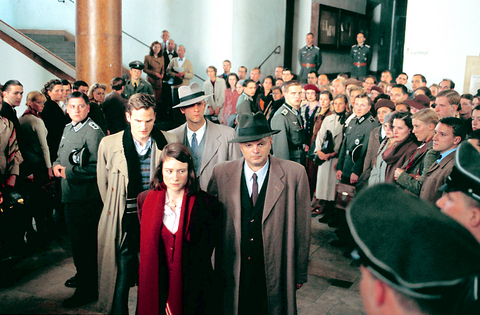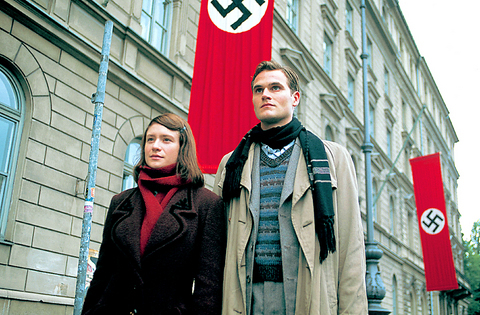Sophie Scholl: The Final Days conveys what it must have been like to be a young, smart, idealistic dissenter in Nazi Germany, where no dissent was tolerated.
This gripping true story, directed in a cool, semi-documentary style by the German filmmaker Marc Rothemund from a screenplay by Fred Breinersdorfer, challenges you to gauge your own courage and strength of character should you find yourself in similar circumstances. Would you risk your life the way Sophie Scholl (Julia Jentsch) and a tiny group of fellow students at Munich University did to spread antigovernment leaflets? How would you behave during the kind of relentless interrogations that Sophie endures?
Scholl, whose story has been told in at least two earlier German films (Michael Verhoeven's White Rose and Percy Adlon's Five Last Days), is regarded today in Germany as a national heroine. Much of the movie, an Oscar nominee this year for best foreign-language film, is based on documents and court transcripts hidden in East German archives until 1990.

PHOTO COURTESY OF CROWN FILMS
The movie follows the last six days of Sophie's life, after she and her brother Hans (Fabian Hinrichs) are arrested at Munich University in February 1943 for printing and distributing anti-Nazi leaflets. Their arrest takes place in a political climate of panic and denial after Germany's defeat at Stalingrad. News of the rout has begun to circulate, but the powers-that-be dig in their heels.
The Scholl siblings belong to the White Rose, a tiny resistance movement at Munich University. The pamphlet they distribute in the university's empty halls, while classes are in session, declares that the war cannot be won and urges Germany to sue for peace. They naively hope to ignite a spontaneous student rebellion.
But the Nazi attitude toward the reversal of Germany's fortunes on the battlefield is one of enraged denial. The shrill accusations leveled against Sophie and two of the other accused in the interrogation room and in court by the fulminating judge, Dr. Roland Freisler (Andre Hennicke), have a tone of desperate, hysterical fury.

PHOTO COURTESY OF CROWN FILMS
Sophie Scholl: The Final Days pointedly steers away from unnecessary melodrama and sentimentality to deliver a crisp chronology of events told entirely from Sophie's perspective, with minimal back story. As the brother and sister race to distribute the leaflets, the movie refuses to underline the built-in suspense. Apprehended by an alert janitor just as they are blending into a milling crowd of students, they are hustled to Gestapo headquarters and interrogated separately.
As Sophie undergoes the first grueling hours of minute cross-examination by Robert Mohr (Alexander Held), an icy, contemp-tuous criminologist with a mind Columbo might envy, she maintains a remarkable composure, insisting that she is apolitical and relating an elaborate cover story involving the transportation of laundry in the suitcase that carried the leaflets.
Sophie wins the first round of this cat-and-mouse game and is about to be released when investigators searching her apartment turn up more incriminating evidence. Even after her story crumbles, Mohr, who has a son roughly Sophie's age, is not entirely unmoved by her arguments, and near the end of her confinement, he offers her an unacceptable deal to save her own life. At each turning point, Sophie, who is deeply religious, prays to God for help.
On learning that Hans has confessed, she finally admits her complicity but continues trying to protect other members of the group, especially Christoph Probst (Florian Stetter), who is married with children. But eventually he is brought into custody.
We meet Sophie's sympathetic cellmate, Else Gebel (Johanna Gastdorf), an avowed Communist, and Sophie's supportive parents, who cheer her on in a subdued, wrenching farewell. Jentsch's portrayal of Sophie is the more impressive for its complete lack of histrionics. Yes, Sophie is a heroine, but not one given to Joan of Arc-style theatrics. An opti-mistic, life-loving student with a boyfriend and a rich future ahead of her, she is the kind of decent, principled person we would all like to be.

Taiwan Power Co (Taipower, 台電) and the New Taipei City Government in May last year agreed to allow the activation of a spent fuel storage facility for the Jinshan Nuclear Power Plant in Shihmen District (石門). The deal ended eleven years of legal wrangling. According to the Taipower announcement, the city government engaged in repeated delays, failing to approve water and soil conservation plans. Taipower said at the time that plans for another dry storage facility for the Guosheng Nuclear Power Plant in New Taipei City’s Wanli District (萬里) remained stuck in legal limbo. Later that year an agreement was reached

What does the Taiwan People’s Party (TPP) in the Huang Kuo-chang (黃國昌) era stand for? What sets it apart from their allies, the Chinese Nationalist Party (KMT)? With some shifts in tone and emphasis, the KMT’s stances have not changed significantly since the late 2000s and the era of former president Ma Ying-jeou (馬英九). The Democratic Progressive Party’s (DPP) current platform formed in the mid-2010s under the guidance of Tsai Ing-wen (蔡英文), and current President William Lai (賴清德) campaigned on continuity. Though their ideological stances may be a bit stale, they have the advantage of being broadly understood by the voters.

In a high-rise office building in Taipei’s government district, the primary agency for maintaining links to Thailand’s 108 Yunnan villages — which are home to a population of around 200,000 descendants of the Chinese Nationalist Party (KMT) armies stranded in Thailand following the Chinese Civil War — is the Overseas Community Affairs Council (OCAC). Established in China in 1926, the OCAC was born of a mandate to support Chinese education, culture and economic development in far flung Chinese diaspora communities, which, especially in southeast Asia, had underwritten the military insurgencies against the Qing Dynasty that led to the founding of

Artifacts found at archeological sites in France and Spain along the Bay of Biscay shoreline show that humans have been crafting tools from whale bones since more than 20,000 years ago, illustrating anew the resourcefulness of prehistoric people. The tools, primarily hunting implements such as projectile points, were fashioned from the bones of at least five species of large whales, the researchers said. Bones from sperm whales were the most abundant, followed by fin whales, gray whales, right or bowhead whales — two species indistinguishable with the analytical method used in the study — and blue whales. With seafaring capabilities by humans